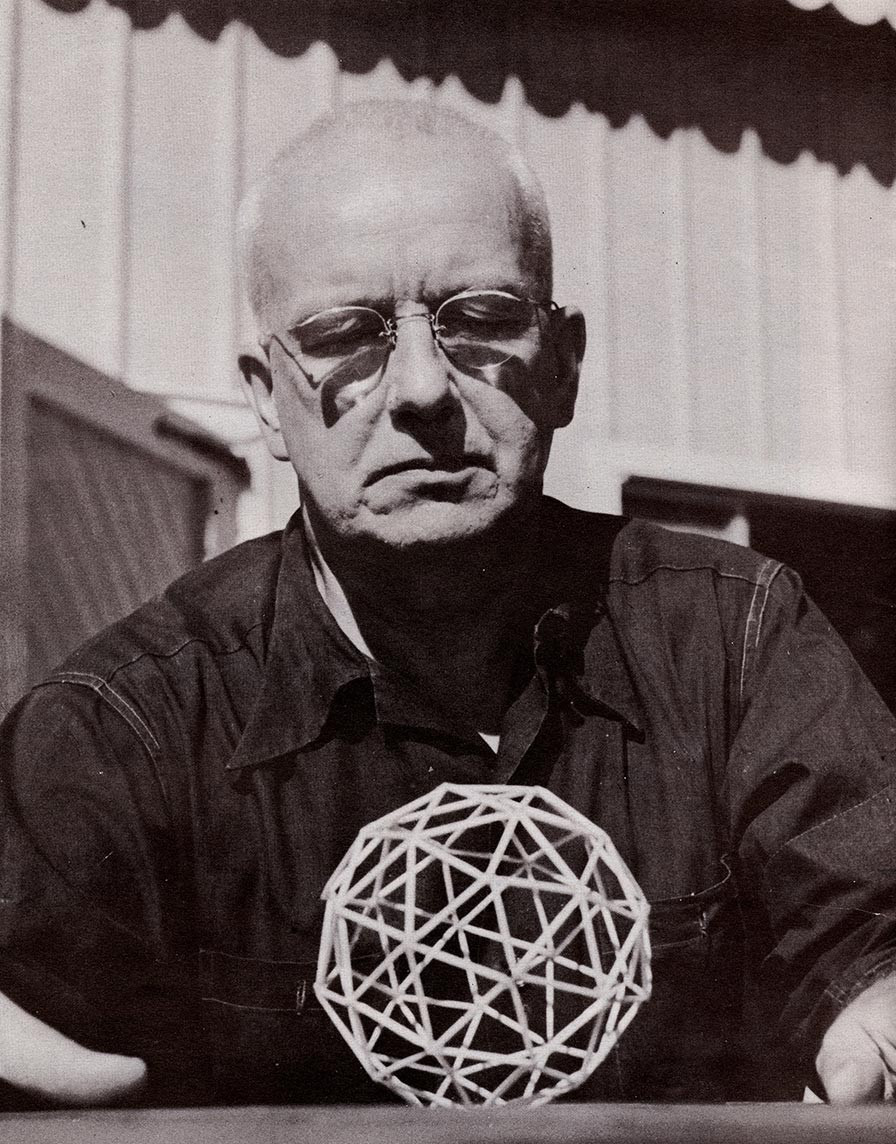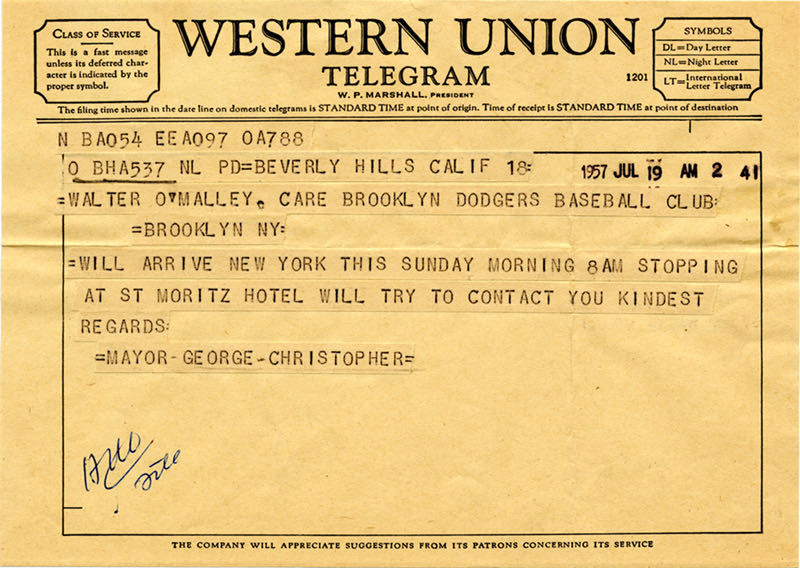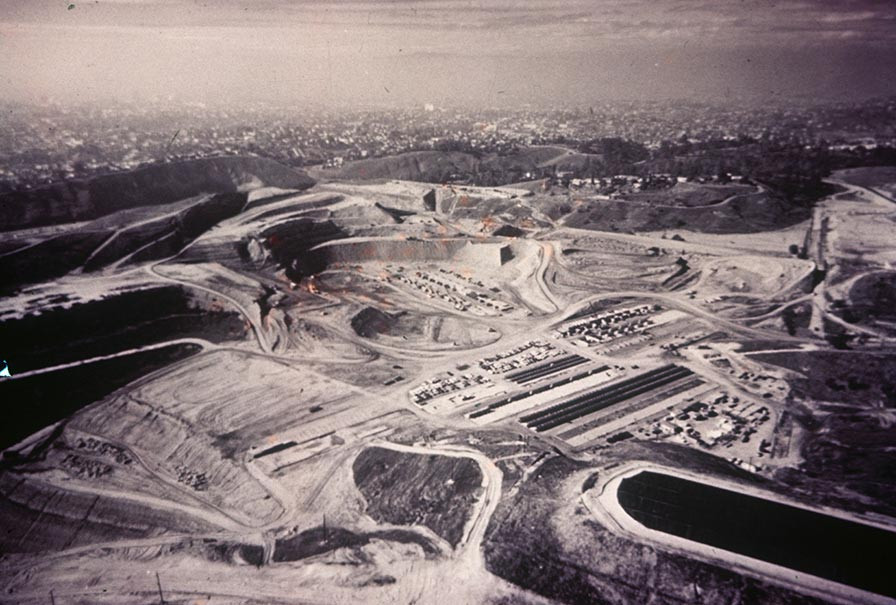This Day in Walter O’Malley History:
-
After corresponding in May and June, Walter O’Malley has lunch with designer and inventor R. Buckminster Fuller to discuss dome stadium ideas for the Dodgers in Brooklyn. For nearly 20 years, O’Malley and Fuller maintained a friendly relationship, corresponded and met on occasion.
-
San Francisco Mayor George Christopher sends a telegram to Walter O’Malley: “Will arrive New York this Sunday morning 8 am. Stopping at St. Moritz Hotel. Will try to contact you. Kindest Regards, Mayor George Christopher.”
-
Walter O’Malley answers a letter from the City of Westminster, California in which the Orange County community wanted the Dodgers to consider the city for the necessary land on which to build their new stadium. In his note to James E. Black, City Clerk of Westminster, O’Malley says, “Thank you for your letter of July 15th, and map enclosed. You will understand, I am sure, that we must proceed with the Appeal (in the courts) before showing any interest in alternate sites particularly in view of the fact that this matter has already been the subject of a successful referendum (in the City of Los Angeles).”
-
Walter O’Malley writes a letter to J.G. Taylor Spink, Publisher of The Sporting News regarding the National League expansion committee’s plans to add teams. “In answer to your inquiry, the National League is definitely committed to expansion. The trail will first take us to the Continental League where inquiry will be made to find out if it is making progress to go Major League. In the event, however, that expansion must come by way of increased membership in the National League, the Committee will investigate applications and report to the League. Six votes in the League would be needed to admit two new members. Unanimous vote was needed yesterday to pass permissive legislation to enlarge membership to ten clubs. In answer to your question, it is true that some consideration was given to my suggestion that each league go to nine clubs playing mainly in three divisions but with a limited inter-locking schedule with the other clubs. This idea did not appeal to the ‘traditionalists’ and I understand it but I do think the public would like it. It would also lay a basic foundation for ultimate expansion from three six-club divisions to three eight-club Major Leagues. This plan, however, did not receive any important support at yesterday’s meeting...Baseball, as you know, had created the machinery for the Pacific Coast League to go Major League and had established ‘Open Classification’ pending the Pacific Coast League declaring itself ‘Major League.’ This never happened. Baseball similarly outlined a program tailored to suit the Continental League’s ambitions. At the time the program was created it was accepted as being fair by the Continental League. We will now try to find out if the Continental League is, in fact, ready to go Major League.”
-
Walter O’Malley sends a letter to Franklin S. Payne, Publisher of the Los Angeles Examiner agreeing to serve as a member of the Honorary Committee of the 2nd International Sports, Vacation and Travel Show in Los Angeles. The Show proceeds were to benefit the Boy Scouts of America.
-
John Drebinger of The New York Times writes of Walter O’Malley’s building of Dodger Stadium. “From the beginning of time, those 300 acres had been nothing more than a mess of rubble, scattered over an unsightly hill and dale. The land must have been an eyesore to the earliest settlers more than 100 years ago. Except for O’Malley’s remarkable maneuver, it doubtless would have remained so for another 100. As if by magic, the rubble is giving way to an elegant structure. In a sprawling metropolis that fairly dotes on the spectacular, the few dissenters no longer have a chance. Merely watching the towering four-tiered arena take shape is an awesome spectacle...When completed, which should be well in advance of the opening of the 1962 season, the stadium will have a seating capacity of 56,000. Whenever a Dodger bungles a play, which, with the Dodgers, is a natural development, no spectator will have to ask his neighbor what happened. Each 22-in-wide theatre-type seat will offer a clear, unobstructed view of the playing field. Circled behind the stadium is the once 700-foot hill which O’Malley has whittled down to the parking area. It will be terraced at four levels, each level even with one of the four tiers of the stadium...It required 8,000,000 cubic yards of excavation to achieve all this. But when finished it will accommodate 16,000 cars, all conveniently parked as close to the stadium as it is possible to design...But O’Malley’s greatest source of pride is from the fact that when all is finished he will be able to sit back and say ‘This is all ours.’ At least it will be, except for what he’ll owe the bank.” John Drebinger, The New York Times, July 20, 1961




